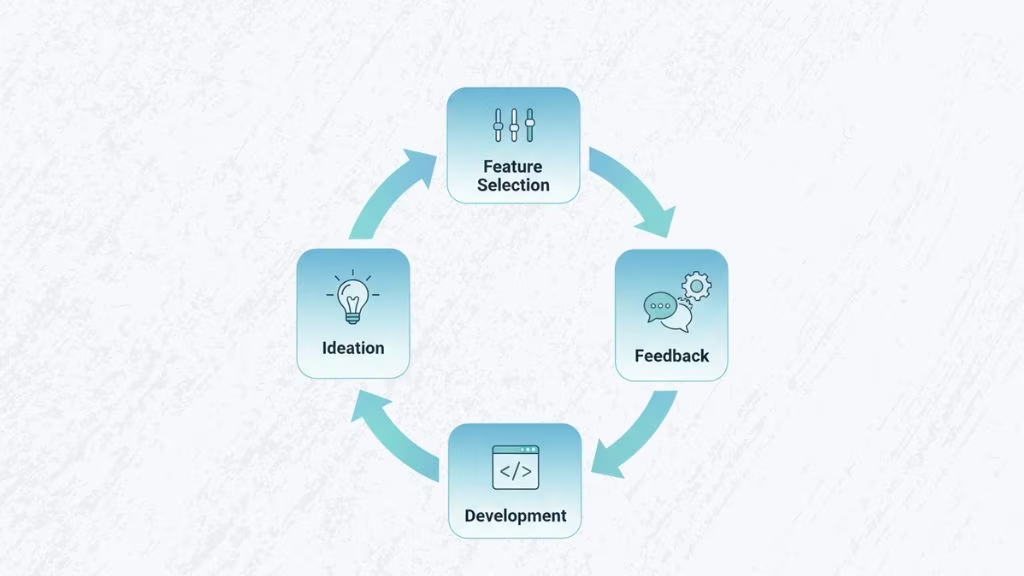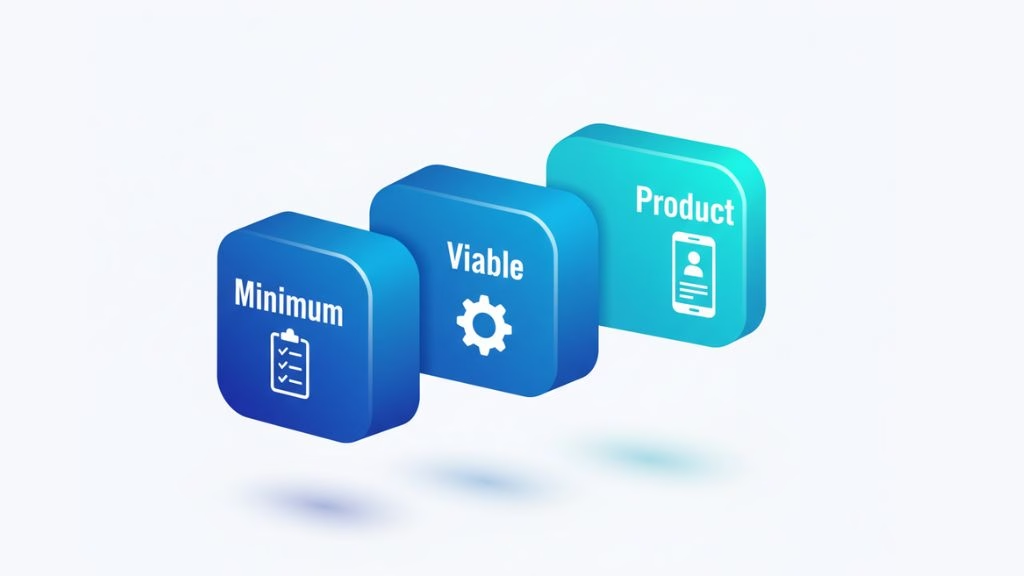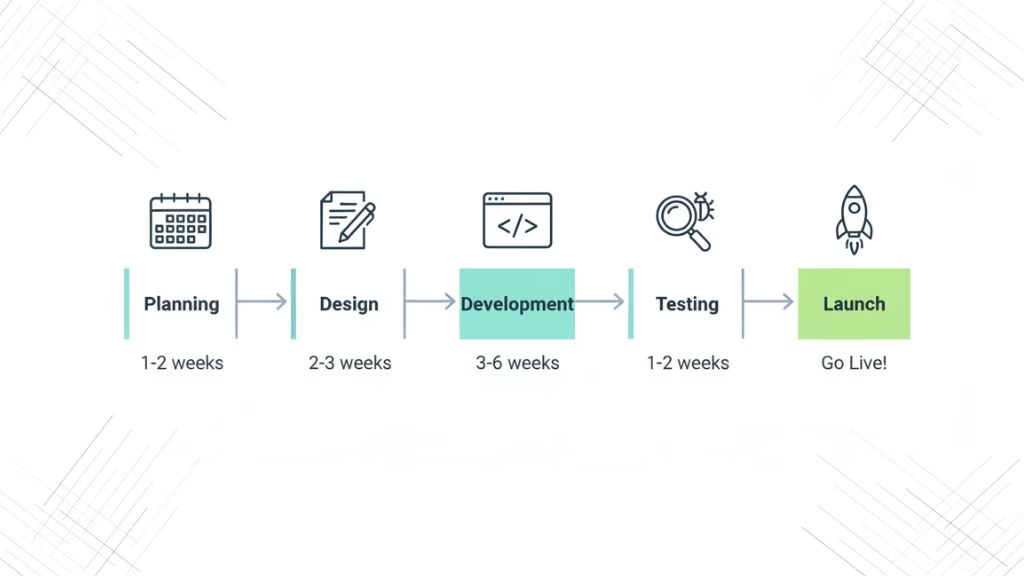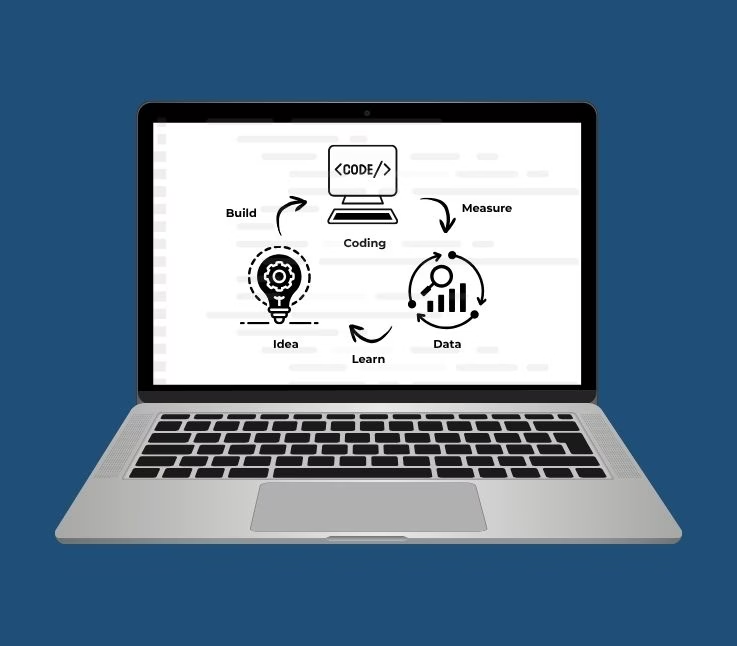- What is MVP Development
- What is MVP Development Process: Step-by-Step
- What Are the 3 Elements of an MVP in Software Development
- What Are the Key Types of MVPs
- What Should You Consider During MVP Development
- What Is the Typical Timeline for MVP Development
- What Is the Difference Between an MVP and a Prototype
- How to Develop an MVP That Solves a Real Problem
- Conclusion
- Frequently Asked Questions (FAQs)
An MVP (Minimum Viable Product) is the simplest version of your product that still delivers enough value to early users. It’s a powerful tool for validating your ideas with minimal investment, enabling you to test assumptions and gather user feedback before scaling.
Many startups spend too much time and money developing a product only to find that the market isn’t ready for it, or worse, that the product doesn’t meet customer needs.
In this guide, we’ll walk you through every step of the MVP development process, from ideation to feedback collection. Whether you’re an entrepreneur testing a new idea or a product manager looking to refine your approach, this comprehensive guide will help you build an MVP that sets you on the path to success.
By the end of this article, you will understand how to prioritize features, develop a scalable MVP, and make informed decisions about next steps after gathering user feedback.
What is MVP Development?
MVP (Minimum Viable Product) development is the process of building the simplest version of a product that still provides enough value to users to validate an idea, gather feedback, and learn about the market. The goal of MVP development is to quickly test assumptions and determine whether there’s demand for the product with minimal investment of time and resources.
In MVP development, the focus is on creating a functional version of the product that solves a specific problem for users, but with only the core features needed to meet their needs. This allows startups and entrepreneurs to avoid overbuilding or wasting resources on features that might not be necessary.
Key Aspects of MVP Development:
MVP development focuses on building the simplest version of a product that delivers real value while validating assumptions. Its purpose is to learn quickly, reduce risk, and guide smarter product decisions.
- Core Functionality Only – Include just the essential features needed to solve the main user problem.
- User Validation – Release early to real users to gather feedback and confirm product–market fit.
- Fast Iteration – Build, measure, and learn rapidly to refine the product with each version.
- Resource Efficiency – Save time and budget by avoiding unnecessary features or overengineering.
- Data-Driven Insight – Use analytics and user behavior to decide whether to pivot, improve, or scale.
- Scalable Foundation – Design the MVP to evolve easily into a full product as demand grows.
What is MVP Development Process: Step-by-Step

Developing an MVP requires a structured approach to ensure that every step moves you closer to validating your product idea. Here’s a breakdown of the MVP development process, step by step:
1. Ideation & Problem Definition
- Understand the Problem: Ensure the problem your product aims to solve is clear and meaningful. This is the foundation of your MVP.
- Identify Your Target Audience: Know exactly who will benefit from your product. Create detailed buyer personas to guide development and design.
- Market Research: Conduct thorough market research to verify that there is demand for your solution. Understand your competitors and the market gaps.
2. Core Feature Selection & Solution Design
- Prioritize Essential Features: Use methods like MoSCoW or RICE to prioritize the most crucial features for your MVP. Avoid the temptation to include non-essential features.
- Simplify the Solution: Your MVP should only include the bare minimum required to address the core problem. This ensures efficiency and cost-effectiveness.
- Design the User Experience (UX): Keep the user journey simple and intuitive. Design wireframes to map out the core user flows and interactions.
3. Development & Testing
- Choose the Right Technology Stack: Select tools and technologies that fit your needs and resources. The focus here should be on scalability and simplicity.
- Develop the MVP: Begin building your product with only the essential features. Use an agile approach to enable flexibility and quick iterations.
- Testing: Conduct internal testing to ensure the product works as expected. Focus on core functionality and usability.
4. Feedback Collection
- Release to Early Adopters: Launch your MVP to a small group of target users. This allows you to gather real-world insights into how the product performs.
- Collect User Feedback: Use surveys, interviews, and analytics tools to gather qualitative and quantitative feedback from your users.
- Monitor Interactions: Pay attention to how users interact with the MVP and identify any obstacles or pain points they face.
5. Iteration & Refinement
- Analyze Feedback: Review all user feedback and data collected during the MVP launch. Look for patterns in user behavior and pain points.
- Refine the MVP: Based on the feedback, make necessary adjustments to the MVP. Focus on improving usability, fixing bugs, and enhancing core features.
- Plan Next Steps: After iterating on the MVP, decide whether to move forward with further development, pivot to a new idea, or discontinue the product.
What Are the 3 Elements of an MVP in Software Development?

An MVP (Minimum Viable Product) is built around three fundamental elements, Minimum, Viable, and Product. Each element plays a specific role in ensuring your MVP delivers value while staying lean, testable, and scalable.
1. Minimum – The Simplest Possible Version
“Minimum” means focusing on the bare essentials. Your MVP should include only the features required to solve the core problem for early users, nothing more.
- Avoid overengineering or adding “nice-to-have” features.
- Concentrate on what directly supports your main value proposition.
- The goal is speed and efficiency, getting your idea into users’ hands quickly.
2. Viable – Functional and Usable
“Viable” ensures that even the simplest version of your product is still usable and valuable. It must deliver a working solution that users can interact with and benefit from.
- Ensure a seamless user experience with minimal bugs.
- Focus on stability and essential functionality.
- Provide enough value so users understand the potential of the full product.
3. Product – A Tangible Solution
“Product” represents the tangible, working version of your idea that real users can test in real conditions. Unlike a prototype or concept, an MVP is functional software that provides feedback based on actual usage.
- It should be deployable and accessible to users.
- Collect measurable data (engagement, retention, satisfaction).
- Use insights to iterate, validate your concept, and guide future development.
What Are the Key Types of MVPs?
There isn’t just one way to build a Minimum Viable Product (MVP). Depending on your product idea, goals, and resources, you can choose from different types of MVPs, each designed to validate assumptions at a specific stage of your startup journey.
Below are the most common and effective types of MVPs used in software and product development.
| Type of MVP | Purpose | Effort Level | Best For |
|---|---|---|---|
| Concierge MVP | Validate service concept manually | Low | Service-based ideas |
| Wizard of Oz MVP | Simulate automation behind the scenes | Medium | Testing user demand |
| Landing Page MVP | Test interest via sign-ups or clicks | Low | Early-stage validation |
| Single-Feature MVP | Focus on one key feature | Medium | Product-focused startups |
| Piecemeal MVP | Combine existing tools | Medium | Budget-conscious startups |
| Prototype/Demo MVP | Visualize product idea | Low | Early investor or user validation |
What Should You Consider During MVP Development?
Building an MVP isn’t just about selecting features and launching a product. There are several critical factors that influence how successful your MVP will be. These considerations will ensure that you’re creating an MVP that not only tests your assumptions but is also poised for future scalability and success.
1. Development Skills Required
To build an MVP, you’ll need the right talent with diverse skills. Depending on your project, this may include:
- UI/UX Design: Essential for creating a seamless and intuitive user experience.
- Frontend and Backend Development: Depending on whether your MVP is web-based or mobile, developers need to implement the core features effectively.
- Quality Assurance (QA): Ensuring the MVP is stable, bug-free, and ready for user testing.
2. In-House vs. Outsourcing for MVP Development
One important decision is whether to build your MVP in-house or outsource development:
- In-House Development: Provides better control and faster iteration. However, it may be more resource-intensive and expensive.
- Outsourcing: Cost-effective, especially for startups with limited resources, but requires careful management to ensure quality and meet deadlines.
- Hybrid Approach: Some startups prefer a hybrid model, combining internal project management with outsourced development for specific tasks, such as design or backend coding.
3. Timeline & Cost Estimation for MVP Development
- Timeline: MVPs can typically be built in 4-6 weeks for simple projects, while more complex MVPs can take 10-12 weeks or more.
- Cost: The cost of building an MVP depends on complexity, features, team size, and whether you outsource or build in-house. On average, MVP development can range from $10,000 to $50,000, with higher costs for more advanced features.
4. Scalability and Flexibility
- Plan for Growth: While the MVP focuses on essential features, it’s important to keep scalability in mind. Your MVP should be built on a flexible architecture that allows for future upgrades and feature additions.
- Choose Tools That Can Scale: Use tools and platforms that can grow with your product. Cloud-based infrastructure, modular code, and APIs can help ensure your MVP can evolve as needed.
What Is the Typical Timeline for MVP Development?

The timeline for MVP development depends on your product’s complexity, team size, and scope, but most MVPs can be built in 4 to 12 weeks. The process follows a series of structured phases that help teams move efficiently from concept to launch while maintaining quality and learning focus. Here is a table which describe typical mvp development timeline breakdown:
| Phase | Duration (Average) | Key Activities |
|---|---|---|
| 1. Discovery & Planning | 1–2 weeks | Define goals, target audience, problem statement, and success metrics. Conduct market and competitor research. |
| 2. Design & Prototyping | 1–2 weeks | Create wireframes, user flows, and basic UI mockups. Identify core features and finalize technology stack. |
| 3. Development Phase | 3–6 weeks | Build the MVP focusing on essential features, core functionality, and backend integration. Conduct internal QA testing. |
| 4. Testing & Quality Assurance | 1–2 weeks | Perform usability tests, fix bugs, and prepare for launch. Validate user journeys and ensure stability. |
| 5. Launch & Feedback Collection | 1–2 weeks | Release the MVP to a small group of early adopters. Gather feedback, analyze usage data, and identify improvements. |
What Is the Difference Between an MVP and a Prototype?
A prototype is a visual or interactive model used to demonstrate how a product will look or work, while an MVP (Minimum Viable Product) is a working version of the product that users can actually use and provide feedback on. Both are essential in product development but serve different purposes and stages in the process.
| Criteria | Prototype | MVP (Minimum Viable Product) |
|---|---|---|
| Purpose | Visualize concept | Validate idea with real users |
| Functionality | Simulated interactions | Fully functional core features |
| Audience | Internal stakeholders | Real users and early adopters |
| Tools Used | Figma, Adobe XD, Sketch | React, Node.js, Angular, Flutter |
| Cost & Time | Low cost, fast to build | Higher cost, requires development time |
| Outcome | Design validation | Market and usability validation |
How to Develop an MVP That Solves a Real Problem
The first step in building a successful MVP is identifying the core problem your product aims to solve. Without a clear understanding of this problem, your MVP risks becoming just another product in a crowded market with no clear value proposition.
Defining the Core Problem:
- Understand your target audience: Identify their pain points and needs.
- Conduct market research: Study competitors and potential users to validate the problem’s existence.
- Create personas: Develop user personas to guide the feature prioritization process.
Feature Selection Best Practices:
- Use prioritization frameworks: Methods like MoSCoW (Must-have, Should-have, Could-have, Won’t-have) or RICE (Reach, Impact, Confidence, Effort) help rank features based on importance and feasibility.
- Avoid feature creep: Stick to the essentials. Resist the temptation to add extra features that won’t directly solve the problem.
- User feedback loops: During the development phase, continuously gather feedback from your target audience to refine which features are truly valuable.
By focusing on solving a specific, validated problem with essential features, your MVP becomes a tool for testing your product’s viability in the real world.
Conclusion
The journey of MVP development doesn’t end with a successful launch. Once you’ve validated your product idea, gathered user feedback, and iterated on your MVP, the next phase is critical for long-term success. Whether your next step involves evolving into a Minimum Lovable Product (MLP) or scaling up to a full-fledged product, your focus should remain on building and growing based on real user insights.
Key Takeaways:
- MVP: Start by building a simple product that solves a real problem.
- Feedback: Gather insights from early users and iterate based on feedback.
- MLP: Add features that make your product lovable and keep users engaged.
- MMP: Make your product market-ready, and prepare to scale.
- Continuous Improvement: Keep refining and expanding your product based on ongoing feedback and performance data.
Frequently Asked Questions (FAQs)
Find clear, expert answers to the most common questions about MVP development, from timelines and costs to tools, strategies, and best practices. This FAQ helps startups and product teams avoid mistakes, validate ideas effectively, and build MVPs that lead to successful, scalable products.
What is an MVP in product development?
Ans: An MVP (Minimum Viable Product) is the simplest version of a product that includes only the essential features needed to meet the core needs of early users. It’s used to validate an idea with minimal investment before scaling.
Why should I build an MVP instead of a full product?
Ans: Building an MVP allows you to test your product idea and validate market demand with minimal resources. It reduces risk by ensuring there is actual user interest before investing in full-scale development.
How long does it take to develop an MVP?
Ans: The timeline for building an MVP varies, but typically, a simple MVP can be built in 4-6 weeks, while more complex MVPs may take 10-12 weeks or longer.
How much does it cost to build an MVP?
Ans: MVP development costs can range from $10,000 to $50,000, depending on factors such as complexity, features, team size, and whether development is done in-house or outsourced.
What is the difference between MVP, MLP, and MMP?
Ans: An MVP (Minimum Viable Product) is a product with only core features to validate an idea. An MLP (Minimum Lovable Product) includes features that delight users. An MMP (Minimum Marketable Product) is feature-complete and market-ready for a broader audience.
What tools can help with MVP development?
Ans: Tools like Sketch or Figma for design, React or Angular for development, and platforms like Firebase or AWS for hosting and infrastructure are commonly used for MVP development.
How do I gather feedback from MVP users?
Ans: You can collect feedback through surveys, user interviews, analytics tools, and beta testing groups. Tools like Google Analytics, Hotjar, or Mixpanel can help track user behavior and provide actionable insights.
What common mistakes should I avoid when developing an MVP?
Ans: Common mistakes include overbuilding (adding unnecessary features), ignoring user feedback, skipping thorough testing, and failing to clearly define the problem your MVP solves.
Can an MVP be used to attract investors?
Ans: Yes, an MVP can be used to showcase product potential and market demand to investors. A successful MVP demonstrates that your idea has traction and can lead to further investment for scaling.
This page was last edited on 19 October 2025, at 9:38 am
How can we help you?
























